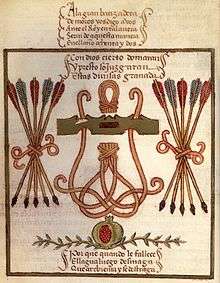Yoke and arrows

The Yoke and the Bundle of Arrows or the Yoke and Arrows (el yugo y el haz de flechas or el yugo y las flechas) is a badge dating back to the Spanish co-monarchy of the Catholic Monarchs Ferdinand II of Aragon and Isabella I of Castile. It served as the symbol of the shield of the monarchy of Ferdinand and Isabella and subsequent Catholic monarchs, representing a united Spain and the "symbol of the heroic virtues of the race".[1] It was also an allusion to the names of the monarchs: Y stood for yugo and for Ysabel (in contemporary spelling) and F stood for flechas and for Fernando. Also, the yoke referred to the legend of the Gordian knot, as did the motto Tanto monta; while the bundle of arrows alluded to the Classical moral story advising that arrows can be easily broken one by one, but are unbreakable if tied together.
In end of the 19th century, the yoke and arrows became a political symbol of the Spanish socialist party. But when all socialist parties decided to have the same icon, the political party Falange adopted it.[2]
 Badge of Ferdinand II and Isabella.
Badge of Ferdinand II and Isabella.- The yoke and arrows on a building in Spain.
.svg.png)
 Flag of the Spanish Falange.
Flag of the Spanish Falange.